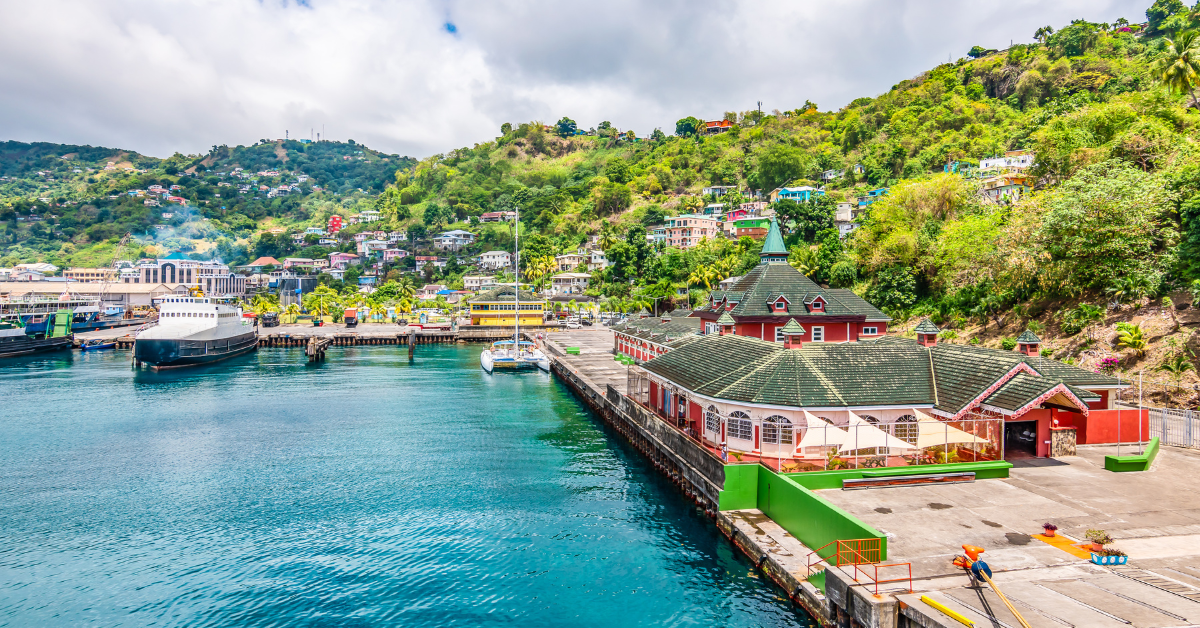Saint Vincent and the Grenadines is a nation where nature and culture coexist harmoniously in the southern Caribbean. In Chinese, it is written as “聖文森特和格林納丁群島,” yet no official Kanji form exists in Japanese. Known for its stunning waters, friendly people, and vibrant music and sports, this “small paradise” continues to attract admiration from around the world.
What kind of country is Saint Vincent and the Grenadines
Saint Vincent and the Grenadines consists of 33 islands, with the main island, Saint Vincent, featuring the active volcano La Soufrière in the north and the smaller Grenadine islands stretching to the south. The country’s population is about 110,000, and the capital is Kingstown. The official language is English, and the education and legal systems have been heavily influenced by Britain.
The economy is primarily based on tourism, agriculture, and fishing, with tourism serving as a major driver of growth. The tropical climate ensures warm temperatures year-round, attracting many visitors who come to enjoy yachting, diving, and other leisure activities.
| Item | Description |
|---|---|
| Country name (Japanese) | セントビンセントおよびグレナディーン諸島 |
| English name | Saint Vincent and the Grenadines |
| Chinese name | 聖文森特和格林納丁群島 |
| Capital | Kingstown |
| Official language | English |
| Currency | East Caribbean Dollar (XCD) |
| Main industries | Tourism, agriculture, fishing |
| Climate | Tropical maritime climate |
Origin of the Kanji “聖文森特和格林納丁群島”
The Chinese name “聖文森特和格林納丁群島” is a phonetic transcription of the English name “Saint Vincent and the Grenadines.” “聖文森特” corresponds to Saint Vincent, while “格林納丁” represents the Grenadines. This is a sound-based translation rather than one based on meaning, and similar methods are used for other Caribbean nations in Chinese.
In contrast, Japanese generally uses katakana for foreign country names. Because Japanese writing prioritizes sound-based notation over semantic translation, the name “聖文森特和格林納丁群島” is recognized only as a Chinese linguistic convention, not as part of Japanese naming practice.
| Language | Writing | Notes |
|---|---|---|
| Japanese | セントビンセントおよびグレナディーン諸島 | Written in katakana |
| English | Saint Vincent and the Grenadines | Official name |
| Chinese | 聖文森特和格林納丁群島 | Phonetic transcription |
| Spanish | San Vicente y las Granadinas | Translation by meaning |
How Japanese People Perceive Saint Vincent and the Grenadines
Although not widely known in Japan, this nation evokes images of “beautiful seas,” “kind people,” and a “peaceful paradise.” For many Japanese, it is seen as a hidden gem distinct from crowded tourist destinations.
The local people are friendly and welcoming, and Japanese visitors often remark on their warmth and hospitality. With its relaxed pace of life and gentle atmosphere, the country appeals to those seeking an escape from the busy rhythms of urban living.
| Common impressions among Japanese people | Description |
|---|---|
| Beautiful nature | Tropical flowers and crystal-clear seas |
| Gentle people | Friendly and kind-hearted citizens |
| Relaxed pace of life | Distinctively slow Caribbean rhythm |
| Famous film location | Setting of Pirates of the Caribbean |
Sports and National Pride
In Saint Vincent and the Grenadines, sports are a vital part of national identity and community life. The most popular sport is cricket, introduced during the British colonial era and now deeply embedded in the culture.
In international competitions, the country competes as part of the West Indies cricket team, representing multiple Caribbean nations. On match days, the streets fill with excitement as people of all ages cheer together.
Soccer is also gaining popularity among the youth. Domestic leagues are developing, and many young athletes aspire to play professionally in regional or European leagues. Through sports, the people foster unity, ambition, and national pride.
| Sport | Popularity | Characteristics |
|---|---|---|
| Cricket | ★★★★★ | National sport, international representation |
| Soccer | ★★★★☆ | Growing rapidly among young generations |
| Track and field | ★★★☆☆ | Prominent in schools |
| Basketball | ★★★☆☆ | Increasingly popular in urban areas |
Culture and Daily Life
The country’s identity blends music, cuisine, and faith into a vibrant and diverse culture. Reggae, soca, and calypso music play constantly in the streets, forming the heartbeat of everyday life.
The local cuisine focuses on seafood, tropical fruits, and richly spiced dishes. Traditional meals often feature plantains and breadfruit. Religion, mainly Christianity, remains central to community life, with faith and family values forming the foundation of society.
| Cultural element | Description |
|---|---|
| Music | Reggae, soca, and calypso are dominant |
| Food | Seafood and spiced tropical cuisine |
| Religion | Christianity is the majority |
| Festivals | Carnival and music festivals are highlights |
Tourism and Harmony with Nature
Saint Vincent and the Grenadines prioritizes sustainability and environmental preservation while promoting tourism. Natural reserves like La Soufrière Volcano and the Tobago Cays Marine Park make it a major eco-tourism destination.
Visitors can enjoy diving, trekking, and yachting while experiencing the country’s rich biodiversity. The government and locals share a strong awareness of protecting their natural heritage, emphasizing eco-friendly and community-based tourism.
Rather than large resorts, travelers often prefer small, peaceful guesthouses where they can engage with locals and experience authentic island life.
| Feature | Description |
|---|---|
| Popular spots | La Soufrière, Bequia, Mustique |
| Activities | Diving, trekking, sailing |
| Tourism style | Eco-tourism and community-centered |
| Film locations | Pirates of the Caribbean filming sites |
Conclusion
The Kanji “聖文森特和格林納丁群島” is the Chinese phonetic representation of Saint Vincent and the Grenadines. Japanese, however, has no official Kanji version, using katakana instead.
This small island nation is known for its stunning natural landscapes, rich culture, and passionate sports spirit. Though far from Japan, it captures visitors’ hearts through its tranquility, warmth, and deep sense of community.
Through tourism, cultural exchange, and sports, Saint Vincent and the Grenadines continues to connect with the world—a peaceful Caribbean paradise that quietly shines on the global stage.






